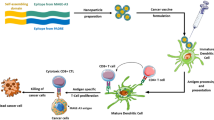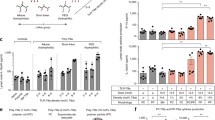Abstract
Protein-based vaccines offer a number of important advantages over organism-based vaccines but generally elicit poor CD8+ T cell responses. We have previously demonstrated that pH-responsive, endosomolytic polymers can enhance protein antigen delivery to major histocompatibility complex class I (MHC-I) antigen presentation pathways thereby augmenting CD8+ T cell responses following immunization. Here, we describe a new family of nanocarriers for protein antigen delivery assembled using architecturally distinct pH-responsive polymers. Reversible addition-fragmentation chain transfer (RAFT) polymerization was used to synthesize linear, hyperbranched, and core-crosslinked copolymers of 2-(N,N-diethylamino)ethyl methacrylate (DEAEMA) and butyl methacrylate (BMA) that were subsequently chain extended with a hydrophilic N,N-dimethylacrylamide (DMA) segment copolymerized with thiol-reactive pyridyl disulfide (PDS) groups. In aqueous solution, polymer chains assembled into 25 nm micellar nanoparticles and enabled efficient and reducible conjugation of a thiolated protein antigen, ovalbumin. Polymers demonstrated pH-dependent membrane-destabilizing activity in an erythrocyte lysis assay, with the hyperbranched and cross-linked polymer architectures exhibiting significantly higher hemolysis at pH ≤ 7.0 than the linear diblock. Antigen delivery with the hyperbranched and cross-linked polymer architecture enhanced in vitro MHC-I antigen presentation relative to free antigen, whereas the linear construct did not have a discernible effect. The hyperbranched system elicited a four- to fivefold increase in MHC-I presentation relative to the cross-linked architecture, demonstrating the superior capacity of the hyperbranched architecture in enhancing MHC-I presentation. This work demonstrates that the architecture of pH-responsive, endosomolytic polymers can have dramatic effects on intracellular antigen delivery, and offers a promising strategy for enhancing CD8+ T cell responses to protein-based vaccines.







Similar content being viewed by others
References
Foged C, Hansen J, Agger EM. License to kill: formulation requirements for optimal priming of CD8(+) CTL responses with particulate vaccine delivery systems. Eur J Pharm Sci. 2012;45(4):482–91.
Yewdell JW. Designing CD8+ T cell vaccines: it’s not rocket science (yet). Current opinion in immunology. Elsevier Ltd; 2010 Jun 1;22(3):402–10.
Reed SG, Orr MT, Fox CB. Key roles of adjuvants in modern vaccines. Nat Med. 2013;19(12):1597–608.
Flatz L, Hegazy AN, Bergthaler A, Verschoor A, Claus C, Fernandez M, et al. Development of replication-defective lymphocytic choriomeningitis virus vectors for the induction of potent CD8+ T cell immunity. Nat Med. 2010;16(3):339–45.
Rollier CS, Reyes-Sandoval A, Cottingham MG, Ewer K, Hill AV. Viral vectors as vaccine platforms: deployment in sight. Curr Opin Immunol. 2011;23(3):377–82.
Liu MA. Immunologic basis of vaccine vectors. Immunity. 2010;33(4):504–15.
Hubbell JA, Thomas SN, Swartz MA. Materials engineering for immunomodulation. Nature. 2009;462(7272):449–60.
Black M, Trent A, Tirrell M, Olive C. Advances in the design and delivery of peptide subunit vaccines with a focus on toll-like receptor agonists. Expert Rev Vaccines. 2010;9(2):157–73.
Moon JJ, Huang B, Irvine DJ. Engineering nano- and microparticles to tune immunity. Adv Mater. 2012;24(28):3724–46.
Ahmed SS, Plotkin SA, Black S, Coffman RL. Assessing the safety of adjuvanted vaccines. Sci Transl Med. 2011;3(93):93rv2.
Wilson JT, Keller S, Manganiello MJ, Cheng C, Lee C-C, Opara C, et al. pH-responsive nanoparticle vaccines for dual-delivery of antigens and immunostimulatory oligonucleotides. ACS Nano. 2013;7(5):3912–25.
Keller S, Wilson JT, Patilea GI, Kern HB, Convertine AJ, Stayton PS. Neutral polymer micelle carriers with pH-responsive, endosome-releasing activity modulate antigen trafficking to enhance CD8(+) T cell responses. J Control Release. 2014;191:24–33.
Moon JJ. Interbilayer-crosslinked multilamellar vesicles as synthetic vaccines for potent humoral and cellular immune responses. Nature Materials. Nature Publishing Group; 2011 Feb 20;10(3):243–51.
Nembrini C, Stano A, Dane KY, Ballester M, van der Vlies AJ, Marsland BJ, et al. Nanoparticle conjugation of antigen enhances cytotoxic T-cell responses in pulmonary vaccination. Proc Natl Acad Sci U S A. 2011;108(44):E989–97.
Lee I-H, Kwon H-K, An S, Kim D, Kim S, Yu MK, et al. Imageable antigen-presenting gold nanoparticle vaccines for effective cancer immunotherapy in vivo. Angew Chem Int Ed. 2012;51:8800–5.
Sahdev P, Ochyl LJ, Moon JJ. Biomaterials for nanoparticle vaccine delivery systems. Pharm Res. 2014; 31: 2563-82.
Joshi VB, Geary SM, Salem AK. Biodegradable particles as vaccine delivery systems: size matters. AAPS J. 2013;15(1):85–94.
Moon JJ, Suh H, Bershteyn A, Stephan MT, Liu H, Huang B, et al. Interbilayer-crosslinked multilamellar vesicles as synthetic vaccines for potent humoral and cellular immune responses. Nat Mater. 2011;10(3):243–51.
Yuba E, Kojima C, Harada A, Tana, Watarai S, Kono K. pH-sensitive fusogenic polymer-modified liposomes as a carrier of antigenic proteins for activation of cellular immunity. Biomaterials. 2010;31(5):943–51.
Andrews CD, Huh M-S, Patton K, Higgins D, Van Nest G, Ott G, et al. Encapsulating immunostimulatory CpG oligonucleotides in listeriolysin O-liposomes promotes a Th1-type response and CTL activity. Mol Pharm. 2012;9(5):1118–25.
Duewell P, Kisser U, Heckelsmiller K, Hoves S, Stoitzner P, Koernig S, et al. ISCOMATRIX adjuvant combines immune activation with antigen delivery to dendritic cells in vivo leading to effective cross-priming of CD8+ T cells. J Immunol. 2011;187(1):55–63.
Zhou W, Moguche AO, Chiu D, Murali-Krishna K, Baneyx F. Just-in-time vaccines: biomineralized calcium phosphate core-immunogen shell nanoparticles induce long-lasting CD8(+) T cell responses in mice. Nanomedicine. 2014;10(3):571–8.
Zhang J, Wu L, Meng F, Wang Z, Deng C, Liu H, et al. pH and reduction dual-bioresponsive polymersomes for efficient intracellular protein delivery. Langmuir. 2012;28(4):2056–65.
Scott EA, Stano A, Gillard M, Maio-Liu AC, Swartz MA, Hubbell JA. Dendritic cell activation and T cell priming with adjuvant- and antigen-loaded oxidation-sensitive polymersomes. Biomaterials. 2012;33(26):6211–9.
Sheng KC, Kalkanidis M, Pouniotis DS, Esparon S, Tang CK, Apostolopoulos V, et al. Delivery of antigen using a novel mannosylated dendrimer potentiates immunogenicity in vitro and in vivo. Eur J Immunol. 2008;38(2):424–36.
Eby JK, Dane KY, O’Neil CP, Hirosue S, Swartz MA, Hubbell JA. Polymer micelles with pyridyl disulfide-coupled antigen travel through lymphatics and show enhanced cellular responses following immunization. Acta Biomater. 2012;8(9):3210–7.
Procko E, Berguig GY, Shen BW, Song Y, Frayo S, Convertine AJ, et al. A computationally designed inhibitor of an Epstein-Barr viral Bcl-2 protein induces apoptosis in infected cells. Cell. 2014;157(7):1644–56.
Chu DSH, Schellinger JG, Shi J, Convertine AJ, Stayton PS, Pun SH. Application of living free radical polymerization for nucleic acid delivery. Acc Chem Res. 2012;45(7):1089–99.
Moad G, Rizzardo E, Thang SH. Living radical polymerization by the RAFT process - A third update. Aust J Chem. 2012;65:985–1076.
Moad G, Rizzardo E, Thang SH. Living radical polymerization by the RAFT process - A second update. Aust J Chem. 2009;62:1402–72.
Moad G, Rizzardo E, Thang SH. Living radical polymerization by the RAFT process - A first update. Aust J Chem. 2006;59:669–92.
Moad G, Rizzardo E, Thang SH. Living radical polymerization by the RAFT process. Aust J Chem. 2005;58:379–410.
Moad G, Rizzardo E, Thang SH. RAFT polymerization and some of its applications. Chem Asian J. 2013;8:1634–44.
Moad G. RAFT-Crosslinking (co)polymerization of multi-olefinic monomers to form polymer networks. Polym Int. 2015;60:15–24.
Chiefari J, Chong YK, Ercole F, Krstina J, Jeffery J, Le TPT, et al. Living free-radical polymerization by reversible addition-fragmentation chain transfer: the RAFT process. Macromolecules. 1998;31(16):5559–62.
Gregory A, Stenzel MH. Complex polymer architectures via RAFT polymerization: from fundamental process to extending the scope using click chemistry and nature’s building blocks. Prog Polym Sci. 2012;37(1):38–105.
Gao H, Matyjaszewski K. Synthesis of functional polymers with controlled architecture by CRP of monomers in the presence of cross-linkers: from stars to gels. Prog Polym Sci. 2009;34(4):317–50.
Bachmann MF, Jennings GT. Vaccine delivery: a matter of size, geometry, kinetics and molecular patterns. Nat Rev Immunol. 2010;10(11):787–96.
De Temmerman M-L, Rejman J, Demeester J, Irvine DJ, Gander B, De Smedt SC. Particulate vaccines: on the quest for optimal delivery and immune response. Drug Discovery Today. Elsevier Ltd; 2011 Jul 1;16(13–14):569–82.
Galloway AL, Murphy A, DeSimone JM, Di J, Herrmann JP, Hunter ME, et al. Development of a nanoparticle-based influenza vaccine using the PRINT technology. Nanomedicine. 2013;9(4):523–31.
Yoo J-W, Irvine DJ, Discher DE, Mitragotri S. Bio-inspired, bioengineered and biomimetic drug delivery carriers. Nature Publishing Group; 2011;10:521-535.
Cheng C, Convertine AJ, Stayton PS, Bryers JD. Multifunctional triblock copolymers for intracellular messenger RNA delivery. Biomaterials. 2012;33(28):6868–76.
Manganiello MJ, Cheng C, Convertine AJ, Bryers JD, Stayton PS. Diblock copolymers with tunable pH transitions for gene delivery. Biomaterials. 2012;33(7):2301–9.
O’Brien N, McKee A, Sherrington DC, Slark AT, Titterton A. Facile, versatile and cost effective route to branched vinyl polymers. Polymer. 2000;41(15):6027–31.
Convertine AJ, Benoit DSW, Duvall CL, Hoffman AS, Stayton PS. Development of a novel endosomolytic diblock copolymer for siRNA delivery. J Control Release. 2009;133(3):221–9.
Crownover EF, Convertine AJ, Stayton PS. pH-responsive polymer–antigen vaccine bioconjugates. Polym Chem. 2011;2(7):1499–504.
Wei Z, Hao X, Kambouris PA, Gan Z, Hughes TC. One-pot synthesis of hyperbranched polymers using small molecule and macro RAFT inimers. Polymer. 2012;53:1429–36.
Murthy N, Robichaud JR, Tirrell DA, Stayton PS, Hoffman AS. The design and synthesis of polymers for eukaryotic membrane disruption. J Control Release. 1999;61(1–2):137–43.
Poly J, Wilson DJ, Destarac M, Taton D. A comprehensive investigation into “controlled/living” chain growth crosslinking copolymerization including a back to basics modeling. J Polym Sci A Polym Chem. 2009;47(20):5313–27.
Wang R, Luo Y, Li B-G, Zhu S. Modeling of branching and gelation in RAFT copolymerization of vinyl/divinyl systems. Macromolecules. 2009;42(1):85–94.
Bannister I, Billingham NC, Armes SP, Rannard SP, Findlay P. Development of branching in living radical copolymerization of vinyl and divinyl monomers. Macromolecules. 2006;39(22):7483–92.
Rosselgong J, Armes SP, Barton W, Price D. Synthesis of highly branched methacrylic copolymers: observation of near-ideal behavior using RAFT polymerization. Macromolecules. 2009;42(16):5919–24.
Hirosue S, Kourtis IC, van der Vlies AJ, Hubbell JA, Swartz MA. Antigen delivery to dendritic cells by poly(propylene sulfide) nanoparticles with disulfide conjugated peptides: cross-presentation and T cell activation. Vaccine. Elsevier Ltd; 2010 Nov 23;28(50):7897–906.
Swartz MA, Hirosue S, Hubbell JA. Engineering approaches to immunotherapy. Sci Transl Med. 2012;4(148):148rv9.
Foster S, Duvall CL, Crownover EF, Hoffman AS, Stayton PS. Intracellular delivery of a protein antigen with an endosomal-releasing polymer enhances CD8 T-cell production and prophylactic vaccine efficacy. Bioconjug Chem. 2010;21(12):2205–12.
Acknowledgments
This research is supported by the Science and Industry Endowment Fund, the National Institutes of Health (R01EB002991 and R21EB014572), the Washington State Life Science Discovery Fund (Grant No. 2496490), the National Science Foundation Graduate Research Fellowship under Grant DGE-1256082 (S.K.), and the Irvington Institute Fellowship Program of the Cancer Research Institute (J.T.W.).
Author information
Authors and Affiliations
Corresponding authors
Additional information
Guest Editor: Aliasger Salem
John T. Wilson and Almar Postma are equally contributing authors.
Electronic Supplementary Material
Below is the link to the electronic supplementary material.
ESM 1
(DOCX 5195 kb)
Rights and permissions
About this article
Cite this article
Wilson, J.T., Postma, A., Keller, S. et al. Enhancement of MHC-I Antigen Presentation via Architectural Control of pH-Responsive, Endosomolytic Polymer Nanoparticles. AAPS J 17, 358–369 (2015). https://doi.org/10.1208/s12248-014-9697-1
Received:
Accepted:
Published:
Issue Date:
DOI: https://doi.org/10.1208/s12248-014-9697-1




